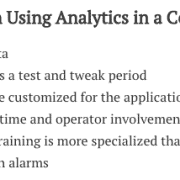2022 Trend #3: AI Literacy Will Become Table Stakes

The Global AI Adoption Index 2022 report recently found that 35% of organizations are deploying AI today and another 42% are exploring these types of technologies.
Along with the tried and true principles of capital, people and operational strategy, the use of AI technology is rapidly becoming a necessary pillar for laying the foundation of business success. With AI changing the way large-scale corporations implement and streamline their processes, measures and protocols, it’s no secret that AI technology is paving the pathway to institutional growth.
The Global AI Adoption Index 2022 report recently found that 35% of organizations are deploying AI today and another 42% are exploring these types of technologies.
Staying abreast of these changes in AI technology and innovation is critical for organizations striving to maintain a competitive footing in the marketplace. Failure to adapt to changing technologies can be devastating for ill-prepared organizations.
Think back to the progression of transportation, communications and electrical power grids over the past century – each of which benefitted exponentially from a layer of intelligence that fueled their performance, speed, efficiency, security and more. The same conceptual premise can be applied to nearly all forms of technology – including the impact of AI on the security industry.
This digital transformation revolution amongst corporate security teams has resulted in an increased need for AI literacy. Today’s security leaders must be able to firmly grasp and apply the concepts of AI in a real-world environment with practical everyday applications – if they don’t, they may quickly get left behind their competitors. workplace.
Why AI Literacy is Important
So what does it mean to “speak AI?” AI literacy is considered a set of competencies that enables individuals to critically evaluate and utilize AI technologies. Understanding these technologies – from both a technical and business standpoint – enables security teams to effectively communicate and collaborate using AI as an effective tool within the workplace.
Did you know that one recent report discovered that over 93% of security operations centers use AI and ML technologies with a goal of improving advanced threat detection capabilities?
Whether your concern is cybersecurity or physical security, early adopters of the technology have realized that proper implementation of AI applications is critical for protecting their facilities and infrastructures.
Understanding the vast complexities of AI technologies has become table stakes for security professionals when it comes to deploying the capabilities needed to protect corporate infrastructures. And forward-thinking teams, knowing that the gap between cyber and physical security is shrinking more and more each day, are implementing a number of approaches when it comes to growing their AI literacy capabilities.
Let’s dive into three of the key principles of AI computer vision technologies you should consider when reviewing AI-based technologies to better security your people, places and things:
Reducing Biases in AI
One common issue related to AI stems from biased data sources. Eliminating these potential biases in AI requires the proper training of AI algorithms to minimize human and systemic biases. Properly training AI software requires developing algorithms that consider a number of different factors beyond the scope of the technology itself. In the physical security realm – enterprise organizations must be able to trust the validity of the data inputs in order to maximize the effectiveness of AI-based systems without bias.
AI-based systems rely upon models that use training data that learns patterns used to perform a number of different tasks including image detection, recognition, classification and more. In order to ensure that systems are accurate and effective, they must hold a strong correlation to data being analyzed in the real world. A system that lacks a homogenous distribution in terms of quantity and quality may ultimately result in suboptimal performance in the system itself.
Reducing the effects of biases can help mitigate any unnecessary negative effects on people affected by the AI technology itself. For example, facial recognition technology that results in false-positives for any one particular group of individuals can result in widespread negative ramifications. In order to counteract these potential issues, physical security teams need to rely upon products that can effectively and simultaneously protect the privacy of its employees and visitors.
At Vintra, we create products and services that minimize potential biases and errors. Our systems are designed to provide opportunities for ongoing feedback and are always subject to human direction and feedback. Vintra’s researchers are devoted to creating systems that mitigate the effects of bias in facial recognition and re-identification systems. Our foundational face Re-ID datasets pull data from over 76 countries using over 20,000 identities that accurately represent people of all segments of the population to help limit potential biases and build a more-accurate solution for our customers.
Using Performance Data to Evaluate AI
Performance data can drastically help security teams evaluate how AI applications are utilized within large-scale enterprises. Physical security teams are demanding data that is both purpose-built for performance and relevant to their applications. With many open-source computer vision algorithms being designed for generic applications such as autonomous driving or online media analyses, physical security teams should focus on the implementation of AI technologies specifically geared towards enhancing physical security as opposed to utilizing inept open-source models. Security is one place where you want your AI vendor to be an inch wide and a mile deep.
The source of training data is crucial when it comes to maximizing the effectiveness of AI security team operations. Gartner has predicted that by 2024, 60% of the data used for the development of AI and analytics projects will be synthetically generated. Security teams need to be well-equipped to assess the validity of this data, understand what questions to ask and be able to test the data effectively.
Some of the considerations when it comes to evaluating AI data include:
- The source of the training data
- Potential hidden biases (human or institutional)
- Security concerns
- Design of algorithms
Let’s face it: physical security teams need all the help they can get to provide a safe and secure workplace environment. Without proper performance data, however, it can be difficult to evaluate and determine the reliability of AI solutions. Think of it this way: You wouldn’t hire a security guard without reviewing their resume to understand their background, their education and their credentials – so you shouldn’t use an algorithmic-assisted decision making tool without understanding exactly how it was trained.
Using a purpose-built solution, evaluated by key metrics such as compute efficiency and accuracy, can provide security teams with the metrics and data needed to quickly and easily scale ML models in a hyper-efficient manner.
How to Evaluate Training Data
Training data is commonly considered the backbone of effective AI models. Training datasets are fed to machine learning algorithms as a means of training machine learning models. As such, implementing the appropriate types of datasets is crucial for maximizing model performance. Without proper AI datasets in place, it can be difficult to ascertain the level of model effectiveness and viability. The problem is how can physical security teams determine if AI models are designed using the highest quality datasets?
Computing data efficiency and accuracy can be performed using a number of standardized validation metrics, including COCO or KITTI. Think of these standards as the equivalent to requesting fuel efficiency in a recently purchased vehicle or a test of accuracy in diagnosing medical procedures.
COCO is a large-scale object detection, segmentation and captioning dataset that stands for “Common Objects in Context.” Using high-quality datasets for computer vision, COCO was created with the sole goal of advancing image recognition using state-of-the-art neural networks. COCO can be used as training datasets for image segmentation into deep learning models and as a benchmark for comparing the performance of real-time object detection. COCO datasets are used to train and measure algorithms that are designed to perform tasks such as object detection, object instance segmentation and stuff segmentation.
KITTI is another data validation technique tool that is popular within datasets for use in mobile robotics and autonomous driving. Using nearly 130,000 images, the KITTI benchmark contains many tasks such as stereo, optical flow, visual odometry and can help validate large datasets. As the gold standards of measurement, both COCO and KITTI can be used to ensure datasets are efficient and accurate prior to implementing hyper-efficient scalability. Using purpose-built solutions created with pre-tested data provides enterprises with models that can be easily scaled throughout their organizations.
How does Vintra stack up against other companies operating against the COCO or KITTI benchmark standards?
Vintra’s enterprise-grade video analytics solutions platform supports modern physical security strategies by using tested high-quality data that maximizes object and event detection without biases. Our synthetic, high-quality training data can be used in new and powerful ways – allowing security teams to help AI vendors deploy accurate, efficient and scalable AI algorithms.
Our platform consistently outperforms other models such as Yolo and SSD that are currently available today by using faster, more-accurate and more-scalable video analytics systems designed specifically for modern security professionals. In an environment where time is of the utmost importance, Vintra’s high-performance technology can help organizations save time, money and may even be life-saving. You can reach out to us here to see how we perform or, better yet, try on our solutions on your video data.
AI Knowledge is Power
With the digital transformation of security organizations gaining momentum, establishing AI literacy within security teams is becoming increasingly more important in 2022 and beyond. Security teams must establish a strong sense of AI literacy that allows them to critically evaluate key technologies while communicating and collaborating in an effective manner.
While doing so, security professionals must utilize AI tools that are purpose-built for performance in their applications in terms of compute efficiency and accuracy. Understanding and verifying the source of data while ensuring it is free from biases is of the utmost importance when it comes to maximizing the effectiveness of AI-based solutions.
At Vintra, we’re proud to help security practitioners and teams develop the tools and knowledge needed to establish a strong sense of AI literacy. Our forward-thinking approach to AI technology will help professionals understand the fundamentals of AI technology to keep them on top of their game. Vintra’s purpose-built solutions help security teams scale AI technologies in a hyper-efficient manner while simultaneously providing a strong foundation of AI knowledge.
Want to help your security teams improve their AI literacy? Click here to learn more.








